Please Note: This page has not been properly updated for several years, especially as regards the ownership and closure of Queensland sugar mills.
Goto: Australian Sugar Industry
Sugar comes from a variety of sources, including a tropical grass (sugar cane), sugar beets, corn (maize) and a variety of palm trees. Sugar cane is grown in tropical and semi-tropical countries around the world, and railways often provided the most economical means of getting the sugar cane to the mill and the resulting sugar to port or market.
Queensland's mill-owned sugar cane railways (aka tramways) provided the main impetus for the CaneSIG website, however an attempt is being made to include materials from other sugar growing areas as well. Please contact the CaneSIG coordinator if you have information that can be shared with other modellers, railfans and historians.
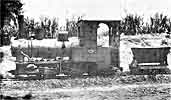
CE Rickwood visited the Sociedad Agricola Cassequel Limitada, who own a sugar mill at Catumbela (on the coastal plain between Lobito and Benguela), in the 1960s. Their primitive open air museum of 60cm equipment included a Krauss (right): Rickwood, CE (1967). '''Coconuts, Cane and Coffee', downloaded 17 April 2009 from The Industrial Railway Record, 13: March, pp 20-25/33 (http://www.irsociety.co.uk/Archives/13/coconuts.htm).

Ledesma: Ledesma SAAI is Argentina's largest sugar producer and is likely one of the largest sugar cane based processing companies (sugar, cellulose, paper, alcohol) in the world.
The history of the mill can be traced back to 1830 when a primitive mill in the San Lorenzo River valley yielded around 759 tons of sugar a year. The mill has used both 508mm and 700mm gauge railways, although the 508mm gauge system had disappeared by the time the photo above was taken.
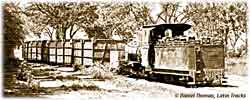
Photos: O&K (above) loco (#12, 0-8-0 700mm gauge, #11548 of 1927, perhaps converted to DH in 1988) and loaded cane train approaching mill, 1982; Daniel Thomas, Latin Tracks magazine, photographer. O&K loco (right) leaving Ledesma Mill with sugar cane bins, 1982; Daniel Thomas photo
Further details of the 700mm mill railway as it was in 1982 can be found in Latin Tracks magazine: Thomas, Daniel (2007). 'The cane trains of Ledesma'; Latin Tracks, #27, pp 35-46, and a series of 'postcard'-type short articles in Narrow Gauge Downunder magazine starting October 2008.

Ocampo: One of the three river ports of Colonia Ocampo (right) in Argentina's northern Santa Fe Province.
"This enterprise of Mr. Manuel Ocampo (a Peruvian who migrated to Argentina in the 19th Century) was a big land and agro-industrial development: three ports, two railways -- meter line and Decauville line, two 'Ingenios' (sugar mills) -- 'Manolo' and 'Tacuarendí', a distillery ('Adelaida'), quebracho and other noble trees timber factory ('aserradero'), the town Villa Ocampo and other items.
"The sugar cane planted come from Guadalupe and Reunión Islands; a French engineer planned and executed all the works." Text and photo provided by Rolando Maggi, Argentine.
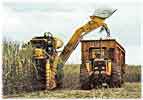
Santa Fe, Argentina, 1999: A short report on the sugar industry in Santa Fe, Argentina. In Spanish. Extracted from: Libro / Book : "Alimentos Santafesinos", Autor: Ministerio de la Producción / Ministry of the Production, Gobierno de la Provincia de Santa Fe / Santa Fe's Provincial Government, Ciudad de Santa Fe / City of Santa Fe, 1999.
Photo: Harvest time in Santa Fe area. Photo from Alimentos Santafesinos.
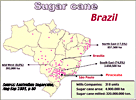
Brazil is a major sugar producer, and has a corporatised system of large sugar mills. Of special interest to world sugar prices, government policy directs the output of the mills into either sugar or ethanol production depending upon world prices and the country's current needs.
Unfortunately, I don't have any details of their sugar haulage systems, whether by rail or otherwise...

Cuba has been a popular railfan destination for decades, with a variety of books, videos, and photo CDs available (see the Bibliography on the Modelling Resources page for a selection). Use photographers John Black or Claus Kleinhapl as search terms in the Image Collection for photographs.
Models of Cuban sugar mill railways can be found in the Member's Models (On30 and G (large) scale). The photo shows Gregario Arlee Manalich 1402 and 1182 'Vulcano', Mercida Cuba, 23 Feb 2003. Photographer: John Black

Martin Heier noted that although almost every bus ride from Luxor to the Valley of the Kings or the Red Sea crosses narrow gauge rail lines, there are surprisingly few reports on these lines. His photos provide a few impressions of a journey 26-29 January 2009 to explore the field lines of the sugar industry in Upper Egypt. [See photos in Image Collection]
Further information from LOK Report: Zuckerrohr feldbahnen in Oberägypten (Sugarcane field railways in Upper Egypt) or this 2009 download.


While the cane railways are now operated by FSC (Fiji Sugar Corporation) most of the mills and their rail operations were initially developed by CSR and parallel similar developments in Australia.
Visitors to the Fijian cane fields and mill railways will see a very run down system, but one that is still very reminiscent of the 1960s in Queensland. Much of the cane is still hand cut and, while the mills did introduce some chopped cane bins, they have reverted to wholestick trucks on the rail lines due to maintenance problems with the bins. The result is long lines of trucks waiting to unload at the mills and a very slow and accident-prone rail system.

Fiji is Australia's closest overseas sugar producing neighbour, and the mill/tramway system was developed similarly to that in Australia. As a result, the Fijian rail systems are quite well reported in Light Railways (LRRSA) and fairly intensively photographed. See Fiji Over the Years - 1963-2008: (Cane Tram Notes) [2.6 Mb pdf file]. Using Fsugar as a search term in the Image Collection will retrieve over 500 images.
The LRRSA has a variety of print resources on Fiji, with current details in Light Railways. Aside from this web site, the best single resource for Fiji's cane trams is Dyer, Peter & Hodge, Peter (1988). Cane Train, Wellington, NZ: The New Zealand Railway and Locomotive Society Inc. ISBN: 0-908573-50-2. It includes photos, plans, maps, etc.


While I worked in India for more than a year, I never managed to get many photos of the Indian railways, and none of the cane growing areas that I visited had any obvious cane railways. However these two photos provide a glimpse of Indian sugar cane operations. The photo right particularly evokes memories for me, not only because of the steam locomotive, but also the houses and people close to the tracks so typical of rural India and Sri Lanka.
Above left: Saraya Sugar Factory's #54, a narrow gauge Kitson-built 0-6-0 with a loaded train of cane in 1993. Above right: Purtabpore Sugar Factory's #2, returning to the sugar factory with a special excursion train in 1984. Both photos from Marshall, Lawrence G (2001). Indian Narrow Gauge Remembered, East Harling, Norfolk, UK: Plateway Press. Very highly recommended.

Use Java as the search term for Javanese photos in the Image Collection. Many of the photos were taken by John Browning on organised railfan tours and his 2008 trip was the subject of a January 2013 Narrow Gauge Downunder magazine article, complete with modelling examples.
The Dutch established the sugar industry in Java with much of the production prior to 1930 going for export, especially to India. However, the depression, the loss of the Indian market with the British setting up plantations there, the WWII Japanese occupation, and more recent urbanisation, saw much of the sugar cane growing land turned to rice or housing.
Original steam driven machinery continues in use in many of the remaining mills and some of the narrow gauge railways used to transport the wholestick cane to the mill still survive. 700mm gauge predominates, but mill railway gauges ranged from 600mm to 750mm. Many of the mills use relatively modern Japanese diesel locomotives but some still use steam locomotives of German or Dutch origin.
The use of narrow gauge railways for transporting cane to the sugar mill has largely been abandoned in favour of road trucks hauling cane to transfer points (transloaders) for final delivery by wholestick truck into the mill. However portable track and hand/bullock power are still used in some areas to transfer cane from the field to a more permanent track.
Steam locomotives are usually fuelled with firewood. However some are fired with bagasse (fibrous cane residue after crushing, dried and bundled), requiring large roofed tenders to carry the low quality fuel. Bagasse bundles will also sometimes be stacked on any horizontal surface of the locomotive.
[Photo above: Padjarakan Sugar Mill, Java: #4 (0-4-0 DM, ex 4wDM, Schola 700mm gauge), John Browning photographer, on his 2012 Christmas card (pdf file)].

Okinawa, Japan c 1970 (right): a tractor-mounted mechanical harvester is ready to load a tractor-hauled four wheel trailer with cane bin following alongside. The height of the leading topper suggests that the cane variety being harvested is fairly short. The bin looks to be narrower than an Australian bin, but the height suggests it likely has a 4-6 ton capacity.
The following notes on sugar cane in Okinawa have been adapted from an article in Wikipedia, the free encyclopedia, downloaded 17 December 2009
While the first rail line (opened with handcars) in Okinawa was laid down in 1902 Okinawa Island's first railroad opened in 1910, for the transportation of sugar cane.
Under the American Occupation, the road system of Okinawa developed markedly, and the prefectural railway and the Okinawa trolley line disappeared. The industrial rail systems disappeared, too, with the exception of the Minami Daito sugar-cane line, which returned to operation and continued to operate until 1983.
Okinawa Railway: Although the original intent was to transport sugar cane by handcar to the refinery in Nishihara, the line was unused in the off-season, and the operator set up a separate company to provide passenger service on the line. It opened in November 1914, providing service between Yonabaru and Konaha, extended its route to Awase in 1916 and ceased operations in 1944.
Daito Sugar Train: The line that operated on Minami Daito Island, now preserved at a park in Naha, is known by various names including "Minami Daito-jima Sato Tetsudo" and "Minami Daito-jima Sugar Train". The first rails laid down in Okinawa included lines that encircled the island and others that relayed traffic to the harbor. The tracks exceeded 30 km in length. In addition to hauling sugar cane, they also conveyed passengers and mails.
In the Meiji period, Minami Daito was uninhabited, but in 1900, Tamaoki Shokai began to develop the island, and started both the sugar refinery and the handcar railway in 1902. In 1917 the commercial rights passed to Toyo Sugar Refining.
The railway was converted to a gauge of 762 mm and began seriously hauling sugar cane. In 1927, Toyo merged with Dainippon Sugar Refining. During World War II, aerial attacks destroyed the railway, but in 1950, Daito Sugar Refining restored it to operation. It served through the 1983 spring season, and thereafter, trucks replaced the railway for the transportation of sugar cane.
The upgrade of the gauge to 762 mm had permitted the use of steam locomotives, and in 1956 diesel locomotives were introduced. At present, steam and diesel locomotives, passenger and freight cars have been preserved on Minami Daito.
Other: Prior to World War II the islands of Ishigaki and Miyako also had lines to move sugar cane.
Tom Eagles' Photos: Tom Eagles visited Okinawa circa 1970 during one of his tours in Vietnam. Tom was a Navy medic attached to the Marine Corps and is highly decorated for his service in the Vietnam war. He is still very active in the 7/8n2 narrow gauge hobby, and models Maine two foot.
Tom says that in finding this place he had no camera, but there was a small country store with a Kodak instant camera of the type they used to sell. He found a piece of lumber and used that for a tripod, so the photos are quite clear considering the poor equipment used to take them. The photos were scanned by Steve King and are used with permission. Use Okinawa or jsugar as a search term in the Image Collection.
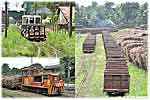

While the Philippines has been a major sugar producer CaneSIG has had limited resources on the sugar cane railways serving the Filipino industry. However, railfan and modeller Jon Knudsen, who travelled there in October 2005 and posted more than 300 images on his now defunct web site. Fortunately he has provided a small selection for CaneSIG. Use psugar as a search term in the Image Collection for full size versions of all images.
The traditional use of bigasse (cane crushing residue) for fueling the steam locomotives can be seen from the high sides and roof on the abandoned steam locomotive tender (above right). There appear to be two types of wholestick cane wagon -- both are essentially flat wagons with high bulkheads, but one type also has a horizontal tie-bar at the top of one side.
Hans Hufnagel's 1985 visit to Central Azucarera de Tarlac (Luzon Island, Philippines) is recorded in Cane Tram Note #15. His 1985 images from Tarlac and other mills are in a slideshow (mp4) format.
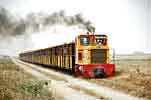
A Taiwanese railfan (CityCat) maintains a web site with photographs and other information on the railways of Taiwan, including the rail lines used by several sugar mills. His historical images are of particular interest (Sugar Railways in Taiwan - 1, about half way down his index page), although there is a good selection of modern sugar cane operations on his photo pages.
Right: Diema DH from CityCat Photos page 2.
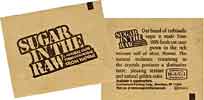
While some of the early plantations used narrow gauge portable rail systems and light equipment, more recent mainland American practice followed US conventional railway practice. In recent decades the standard gauge railways carried cane during the crushing season. The content in this site is likely representative of other sugar cane operations in the same areas.
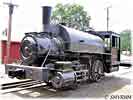
CaneSIG primarily provides resources for modellers of tropical sugar cane railways. However, sugar is also produced in more temperate areas from sugar beet, corn (maize) and other crops. Betteravia is an example of beets delivered to a sugar mill by rail using open gondolas.
The Union Sugar Company mill at Betteravia, California began production in the 1899 harvest season and produced 1607 tons of sugar from 16,000 tons of sugar beet.
Union Sugar, named to represent the union of interests of San Luis Obispo and Santa Barbara Counties, was conceived in the late 1800s and began operations in September of 1899. Originally serviced by the Southern Pacific Railroad and the Pacific Coast Railway, the Santa Maria Valley Railroad became involved after its inception in 1911 and continued hauling beet gondolas for the refinery until the refinery closed in 1993.

US Sugar was the USA's first fully integrated sugar producer, growing, transporting, milling, refining and distributing sugar from a Florida base. Power for the refinery is even generated using bagasse, the fibrous byproduct that remains after sugar cane is crushed. Steven Chapman's photos in and around the refinery can be retrieved from the Image Collection using [USsugar] as the search term. Other US Sugar materials are available from the Modelling Resources page.
A recently published resource: Jennings, Barton. The Railroads of U.S. Sugar: History Through the Miles [Florida].
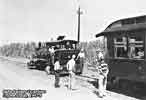
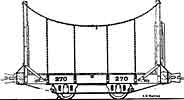
The Hawaiian sugar industry used American railway practice with a variety of relatively small steam locomotives but cane was often carried in proprietary 4 wheel Gregg (solid sides) and Fricke chain-side cane cars.
The January 1933 issue of Economic Geography had a descriptive article on the Oahu Sugar Cane Plantation, Waipahu, which was served by permanent and temporary rail lines. [Off-site JSTOR link].
Nicholas Kalis' has compiled a Cane Tram Note on the Oahu Sugar Company, Waikane [1.3 Mb].
Several 'sugar cane trains' exist for tourists in Hawaii. Current information (and DVDs) should be available from Hawaiian tourist sites.
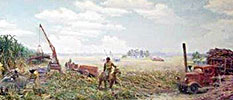
As elsewhere, early sugar cane operations were labour intensive. The Louisiana State Exhibit Museum 1939 era diorama (right) depicts the transition between manual and machine operations.

Following the plantation era the Louisiana cane railway operations generally followed mainstream American practice with Southern Pacific as one of the main operators. Locomotives were typical of other regional branch lines, with cane carried in gondolas and similar freight cars.
The Modelling Resources page has a link to an article on a N scale layout based on Louisiana practice.
Jump to Sugar in Australia or Top of Page
Copyright © A C Lynn Zelmer or the contributor as appropriate. Last updated: 17 March 2024 [lz]; e-mail: Lynn @ ZelmerOz.com